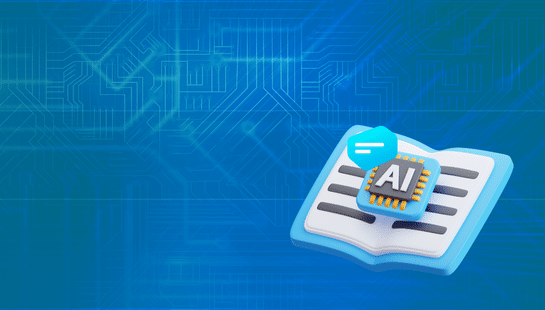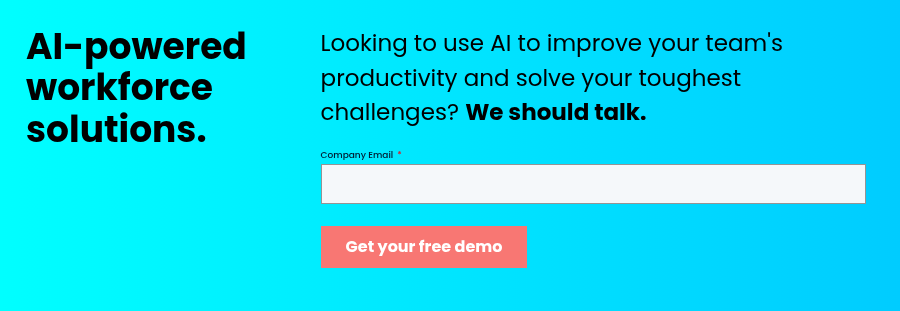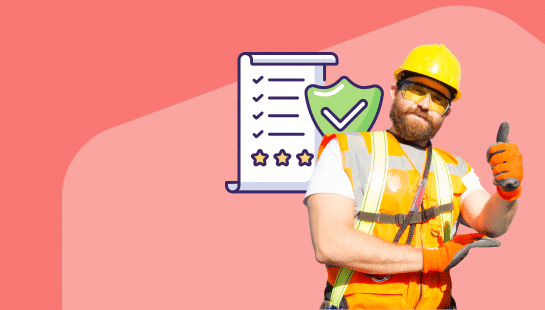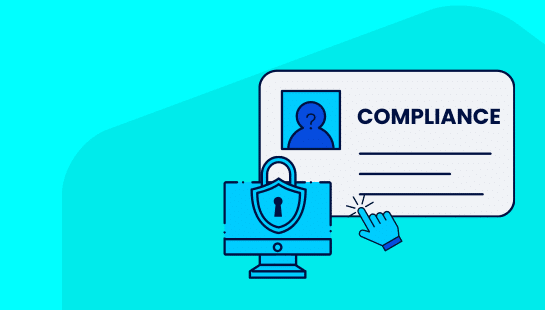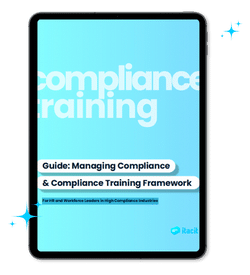AI training programs have seen explosive growth, with employer partners’ AI course applications soaring 800% in just the past year. This remarkable growth emphasizes how AI continues to change workplaces in every industry.
AI brings major challenges too. Phishing emails shot up by 1,265% between Q4 2022 and 2023 as AI technology became more available. On top of that, 77% of companies experienced data breaches in their AI models. These numbers show why proper AI employee training matters so much.
Here’s the bright side: AI training can improve your organization’s efficiency and productivity by a lot. Your team can create adaptable solutions without adding more staff. The right AI training equips your employees to protect data and use AI ethically. They’ll gain skills to work with this powerful technology.
This piece covers everything about setting up effective AI training programs. You’ll find practical ways to keep your workforce competitive in what a world of AI-powered solutions looks like. We’ll explore AI’s role in today’s workplace and show you how to measure your training success.
Understanding the Role of AI in the Modern Workplace
AI doesn’t just change your workplace, it completely reshapes it. Nearly 10% of workers worldwide now have job titles that didn’t exist in 2000, with this figure approaching 20% in the US. This reshaping shows no signs of slowing down.
How AI is transforming job roles
The workplace revolution moves faster than most people realize. C-suite leaders estimate only 4% of employees use generative AI for at least 30% of their daily work. Employee self-reports reveal the actual percentage stands three times higher. This gap demonstrates how AI adoption outpaces leadership awareness.
Job roles have become more fluid and dynamic. Modern professionals will likely hold 20 jobs throughout their careers, almost double the 11 jobs typical in 2010. This rapid job-switching reflects how AI redefines work continuously.
AI impacts various jobs differently:
- Data-rich fields face fastest change: Software development, customer support, and financial analysis see transformation rates of 60-70% because AI has abundant learning data in these areas
- Human-centered roles evolve slower: Childcare, nursing, and construction see much lower transformation rates (below 25%)
- Everyone gets touched: 54% of jobs posted last year will be “moderately” transformed by generative AI
This transformation extends beyond job titles, it changes your daily work. Nearly half (46%) of skills in a typical US job posting head toward “hybrid transformation,” where AI and humans collaborate. McKinsey projects that by 2030, 30% of current US jobs could be automated, and AI tools could substantially alter 60%.
“AI isn’t replacing workers, it’s replacing tasks,” explains one expert. “Your daily work will involve less routine processing and more strategic thinking.”
Why AI literacy is now essential for all employees
AI reshapes almost every job, making technology understanding as basic as email knowledge. AI literacy means having practical knowledge of AI’s capabilities, limitations, and appropriate applications, not just technical skills.
AI literacy skills have soared. LinkedIn profiles showing these skills have increased by 177% since 2023. Hiring managers have noticed too, over half wouldn’t hire someone without AI literacy skills.
AI-literate professionals gain several advantages:
- Career advancement: Learning AI skills sets up professionals for long-term success, making them twice as likely to add these skills today than in 2018
- Positive outlook: 70% of AI-literate employees expect positive outcomes from AI technology compared to just 29% of those with low literacy
- Productivity gains: Teams trained in AI see 20-30% increases in efficiency
Many workers lack proper training despite its importance. More than a fifth report minimal to no support with AI tools. This creates a widening skills gap between AI-haves and have-nots.
Ai-powered learning platforms like iTacit’s employee training LMS offer a solution through structured AI assistance, timely answering employee question. This approach helps bridge the equity gap between frontline and white-collar workers’ access to AI tools. This consideration matters as 40% of workers will just need new job skills within three years due to AI-driven changes.
Success in training requires practical application. One expert notes, “Workers who master AI don’t just know what buttons to push, they understand when to use it, how to assess outputs, and where human judgment still trumps algorithms.”
The Urgency of AI Training: Why Now Matters
Organizations need to get serious about AI training now. AI adoption moves faster than most companies can handle, creating an urgent need to train employees systematically.
The Garter Hype Cycle and timing your training
The Garter Hype Cycle helps plan your AI training timeline effectively. This prominent technology adoption model shows how emerging technologies mature – from the original excitement to real-life application.
In 2025, Generative AI has officially entered the “Trough of Disillusionment” phase of the Hype Cycle. Companies have moved past their initial excitement and now face practical limitations at this crucial point.
Your training strategy’s timing matters more than ever. Organizations currently spend $1.90 million on GenAI initiatives, yet less than 30% of AI leaders say their CEOs are satisfied with the returns. This gap between investment and satisfaction creates a perfect chance to target training effectively.
Different organizations face unique challenges:
- Low-maturity organizations can’t identify good AI use cases and expect too much
- More mature organizations can’t find skilled professionals or build company-wide AI knowledge
Employees just need more AI training opportunities than they receive. Many workers say they need better training to use AI tools effectively. This mismatch between needs and delivery puts businesses at risk.
Almost 25% of businesses already use Generative AI for talent acquisition, making it the top area for GenAI adoption. Another 30% plan to use it within 24 months. But only 14% have AI training policies, and just 8% help develop skills for workers whose jobs AI might affect.
Avoiding the trough of disillusionment
The “Trough of Disillusionment” becomes dangerous when early excitement fades and frustration grows. Companies often hit this phase by rushing into AI projects unprepared.
Half of global IT leaders admit they lack proper AI implementation preparation, citing weak infrastructure as a major obstacle. Failed AI deployments lead companies to wrongly dismiss AI’s value.
Your training strategy must cover these key areas to succeed:
- Role-specific learning paths – Employee groups need different AI skills, but current programs mostly target leaders
- Practical application focus – Training should emphasize real-life use cases over theory
- Critical thinking development – Teams must learn to review AI recommendations and spot “AI hallucinations”
The main barriers to AI training include skill gaps (26%), compliance concerns (23%), and budget constraints (22%). Success requires a systematic approach to tackle these challenges.
“AI-powered tools can be incredibly valuable to businesses when implemented correctly,” notes one expert. “However, less than half of companies that have adopted AI have well-established data responsibility and AI ethics policies”.
AI-powered Learning Management System includes specialized AI training modules. Organizations can track progress while delivering role-appropriate content. This approach helps close the gap between frontline and white-collar workers’ AI access.
Delayed action carries serious risks. Companies that don’t train promptly risk wider skill gaps, bigger economic disparities, and workers unprepared for the ongoing AI revolution.
Note that AI adoption has grown dramatically, but trust has declined as people learn about its benefits and limits. Training builds both technical skills and confidence in these powerful tools.
Bridging the Equity Gap in AI Training
Today’s AI-powered workplace shows a clear divide. Organizations are rushing to implement AI technology, but not everyone gets to participate.
Frontline vs. white-collar access to AI tools
Numbers paint a concerning picture. Over 75% of leaders and managers use generative AI several times weekly. Regular use among frontline employees has stayed at 51%. This creates a two-tier workforce where some thrive with AI help while others lag.
Training numbers look even worse. Only 33% of employees get formal AI training, though 66% want to learn more about AI. This gap keeps growing across different levels:
- 72% of C-suite executives use AI daily while only 18% of individual contributors do
- About 45% of business leaders know how AI affects their jobs, but only 28% of frontline workers get this training
- Only a quarter of frontline employees say their leaders support AI adoption
“The AI skills gap is growing in UK workplaces, with business leaders thriving while frontline workers fall behind,” states one industry report. Many workers don’t deal very well with this situation. More than half of frontline employees ignore corporate rules to use external AI tools when they can’t access official ones.
The risk of a growing skills chasm
Demographics show more gaps in AI training access. Men make up 7 out of 10 workers with AI expertise, while women account for just 3. These numbers get worse in advanced areas like deep learning, where men make up three-quarters of practitioners.
Age creates more barriers. About 45% of Gen Z workers get AI-skilling opportunities. Boomers get nowhere near the same chances – only half as many receive similar training. Usage rates reflect this divide – nearly half of Gen Z actively uses AI compared to about one-third of boomers.
Time spent training really matters. People who get at least five hours of training and face-to-face coaching use AI much more. Yet almost 40% of employees say they don’t have the right tools.
These gaps create real business problems. Workers without training can’t use AI tools well. This leads to lower productivity and security risks. Frontline workers feel left out when they’re excluded from AI projects. About half of Gen Z workers believe their bosses don’t see AI’s value, which creates tension at work.
Why inclusive training is a competitive advantage
Smart organizations know that fixing the AI training gap gives them an edge. Companies that offer fair AI training keep more employees, have happier workers, and compete better.
Financial services companies face a 35-point gap between AI skills they just need and available talent. Companies that fix this grow faster than others. One executive puts it simply: “Artificial intelligence offers tremendous growth opportunities… But that growth can only be unlocked by collectively addressing skills gaps”.
The fix needs several steps:
- Create upskilling programs without degree requirements that block frontline staff
- Use LMS that fit different learning styles
- Give women and underrepresented groups equal chances to learn AI
- Build special programs to help older workers feel confident with AI
Companies that prioritize inclusive AI training avoid what experts call “a two-tier workforce, where those with AI skills reap the rewards of technological advancements and those without them struggle to keep up”.
AI systems keep evolving, and fairness becomes more crucial. Research shows AI might affect women workers twice as much as men because more women work in administrative roles. Workers of color and those with less education worry more about AI taking their jobs.
Fair AI training isn’t just the right thing to do, it’s good business. Companies that train everyone see much higher AI adoption rates and better returns on their tech investments.
Best Practices for Structuring AI Employee Training
A strategic approach, not a one-size-fits-all solution, makes AI training effective. Nearly half of employees surveyed want more formal training and believe it will boost AI adoption. Let’s take a closer look at building an AI training framework that works throughout your organization.
Start with AI literacy for all roles
AI literacy creates the foundation for all other training. Research shows employees need to know the simple concepts, how AI works, how machine learning helps businesses make smarter decisions, and how automation can simplify daily tasks.
Note that AI literacy only affects an organization when every employee knows how to use it. Each role needs different levels of literacy:
- Executives must understand AI’s strategic value and sponsor “skills + guardrails” programs that increase responsible usage
- Managers learn more by hosting “prompt labs” where teams share successful AI approaches
- Individual contributors need practical skills such as using AI for first drafts they can refine
Microsoft demonstrates this principle through its curated AI training for various levels of AI fluency, from simple concepts to advanced applications.
Use role-specific learning paths
Generic “tool training” doesn’t deliver lasting results. Success comes from developing role-based AI competencies that prepare professionals to apply AI within their specific job contexts.
Your training should match your organization’s diverse roles, just as an HR executive needs different AI skills than a finance analyst. To name just one example:
- Marketers learn to use AI for campaign targeting and customer segmentation
- HR analysts focus on using AI to forecast attrition trends
- Cybersecurity teams need skills to implement AI models that detect anomalies
Organizations with the best results offer role-specific tracks, weekly prompt labs, and living prompt libraries with approved templates. Many successful companies have created AI curricula tailored for marketing, HR, operations, and finance.
Incorporate real-life use cases
Abstract concepts rarely stick. Training based on actual workplace applications works better. Here are some real-life examples:
Uber’s AI tools help customer service representatives summarize communications with users and surface context from previous interactions. Representatives became more helpful and effective through training focused on these specific applications.
Dun & Bradstreet created an email-generation tool with AI that helps sellers craft tailored communications to prospects. Their training focused on becoming skilled at this specific application rather than general AI concepts.
Your training should include practical application opportunities beyond theoretical examples. Companies investing in this approach see remarkable improvements:
- 704 Apps trained staff to use AI to measure emotional “temperature” in conversations between drivers and passengers, generating alerts for potentially dangerous situations
- Toyota’s AI training for factory workers cut more than 10,000 man-hours per year
Learning Management System offers specialized modules that deliver practical, role-specific AI training while tracking progress and participation. The system helps organizations maintain consistent quality across departments.
Note that employees who receive at least five hours of instruction with access to in-person guidance show dramatically improved training effectiveness. The right atmosphere matters too, welcome questions, offer hands-on practice, and celebrate wins to reinforce learning.
Industry-Specific AI Training Applications
AI training needs vary by industry. A look at specific sectors shows how targeted AI instruction transforms operations and enhances customer service.
Retail: Enhancing customer service and inventory
Retail employees now use AI tools that improve customer interactions and inventory management. Target’s “Store Companion” app helps staff check prices, locate products, and sign up customers for services. This app-based training lets frontline workers answer customer questions quickly without leaving the sales floor.
Staff members who receive AI training for inventory forecasting can prevent stockouts and overstocking. Employees learn to use AI systems that analyze sales data, market trends, and customer behavior patterns to optimize inventory levels.
Large retailers like Mattress Firm and Five Below have found that AI-powered scheduling tools save manager time and make employee scheduling fairer. Robyn Martin from Mattress Firm states, “We definitely want to use science and data to drive these decisions” rather than subjective priorities.
Healthcare: Streamlining diagnostics and admin
Healthcare professionals get better at patient care through AI-supported decision making. Johns Hopkins University’s AI programs teach healthcare workers to use predictive analytics that forecast complications and manage information overload.
Healthcare AI training covers these critical areas:
- Disease spread assessment using epidemiological models like SEIR during pandemics
- Using large language models to automate administrative tasks
- Graph analytics analysis to identify health risks and comorbidity patterns
Harvard Medical School’s eight-week program helps healthcare leaders “review existing AI systems in health care to understand their strengths and weaknesses”. Medical professionals can implement AI solutions that address real clinical needs through this practical approach.
Insurance: Automating claims and triage
Insurance companies see major operational improvements through AI training. AI-trained claims adjusters use systems that automate claims intake, confirm documentation, and assess property or vehicle damage using natural language processing and image recognition.
Claims triage training shows adjusters how AI can “prioritize different requests based on complexity and urgency”. Simple claims get processed automatically while complex cases go to human experts. Staff using AI can process claims faster, J.D. Power data shows satisfied customers who find claims processes easy are twice as likely to renew policies.
Fraud detection remains another vital training area. Insurance professionals learn how machine learning models analyze historical claims data to identify suspicious patterns in real time, with FBI estimates putting fraud-related losses at more than $40 billion annually.
Hospitality: Personalizing guest experiences
Hospitality AI training focuses on creating tailored experiences throughout the guest’s stay. Hotel staff trained on AI systems learn to use customer data that creates personalized experiences “from the moment they book to the second they check out”.
Virgin Hotels leads with training programs for their “Lucy” app, which connects to smart room systems. Staff help guests control room features like lighting, temperature, and entertainment through the app. This creates an uninterrupted experience that remembers priorities from past visits.
Front-desk personnel learn about AI-powered chatbots that provide 24/7 assistance in multiple languages. Lidl uses similar training for customer support teams. Their staff combines automated AI responses for simple questions with human support for complex issues.
Learning Management Systems deliver these industry-specific AI training programs. Organizations can track progress while providing role-appropriate content for different staff positions. This approach connects theoretical knowledge with ground applications, making AI valuable in a variety of business sectors.
Building a Culture of Continuous AI Learning
AI adoption needs more than basic training. Research shows that 50% of employees want structured training programs. They see this as crucial for AI adoption, yet more than a fifth say they lack proper support.
Encouraging experimentation and feedback
The most successful companies build what experts call an “experimentation culture” around AI. This helps team members overcome their reluctance to develop AI skills. The practical steps include:
- Setting up safe sandbox environments for AI tool testing
- Creating opportunities to learn from mistakes
- Letting staff explore AI tools that fit their job roles
Companies that embrace this experimental mindset see much better adoption rates. Research proves that organizations with strong learning cultures are 46% more likely to lead the market and 92% more likely to invent new solutions.
Creating internal AI learning communities
Learning hubs help speed up AI adoption throughout your company. These spaces break down departmental barriers and boost team collaboration through knowledge sharing.
Your AI learning hub can be simple yet effective. A Microsoft Teams space with clear posting guidelines and regular updates works well. Success depends on steady engagement through monthly webinars, useful resources, or group discussions.
The 35-44 age group shows the most AI experience and enthusiasm. These millennials often lead teams and naturally champion change. Their management positions help them guide others to become better AI users. Two-thirds of them answer questions about AI tools every week.
Recognizing and rewarding AI skill growth
Good recognition programs boost learning motivation. Public praise and financial rewards make a big difference in workplace learning.
IBM’s research shows striking differences – 84% of employees in top organizations get proper development versus just 16% in underperforming ones. The value of training shows clearly – 94% of staff who stayed despite other job offers credit their company’s commitment to development.
Linking AI skills to career growth makes sense. About 40% of employees might leave if they don’t get proper AI training. LMS tracks progress and delivers role-specific AI training modules.
The best results come when learning becomes part of company culture. Executives should take part in training and share their learning experiences.
Tools and Platforms to Support AI Training
The right tools make all the difference at the time you roll out AI training programs. Several platforms now provide specialized features that deliver AI training to fit your organization’s needs.
Using iTacit’s LMS for AI training delivery
iTacit’s Learning Management System acts as a centralized hub where employees access AI-powered HR assistant resources. The platform’s microlearning capabilities put bite-sized chunks of AI training directly in your team’s hands. Staff members can find training, scan relevant AI topics, and enjoy a tailored experience through its mobile-first approach.
The system’s AI Assistant keeps company policies and training documents within reach. Team members can ask questions and get instant, role-specific answers from your organization’s knowledge base. The data shows that 87% of users find answers more easily than before.
iTacit stands out with its user-friendly interface. Your HR teams can manage it without technical skills and customize responses without coding or IT support.
Tracking progress and engagement
AI training platforms provide resilient analytics to monitor employee development. Advanced reporting tools help you track individual progress and improve skill development consistently.
AI-powered analytics spot skill gaps and adjust training accordingly. These tools go beyond simple metrics and connect training data to business effects, which helps prove ROI.
KPMG’s GenAI 101 program improves its workforce’s capabilities in AI applications while tracking employee progress. Ally Financial’s quarterly ‘AI Days’ give employees chances to watch live demos of AI tools. The company also holds monthly gatherings where interested staff can join office hours with data science experts.
Companies that use AI for training save about $1.30 million each year through reduced administrative work and better learning pathways.
Measuring Success and Adapting Over Time
Results tracking can turn good AI training programs into exceptional ones. Organizations need multiple ways to measure and optimize their AI investment, according to research.
Key metrics to track training effectiveness
A combination of different metrics creates the most effective measurement:
- Model quality metrics evaluate how well employees use AI tools
- Operational metrics measure how AI affects business processes and boosts productivity
- ROI analysis demonstrates how training supports strategic goals
Most companies call their AI investments successful with returns below 50%, and they understand that AI delivers strategic value beyond financial gains.
Adapting content as AI evolves
Up-to-the-minute data analysis helps identify trends and suggests program improvements. AI can spot problems and recommend changes whenever a module doesn’t perform well.
Being proactive becomes easier with predictive analytics through:
- Analysis of employee behavior and performance data
- Detection of skill gaps and emerging trends
- Prediction of skills that become essential during career progression
AI-powered LMS helps monitor this progress by automatically adjusting training paths based on performance data.
Gathering employee feedback for improvement
Employee reactions play a crucial role. AI makes this process simpler through:
- Automated surveys and chatbots that collect immediate feedback
- Sentiment analysis that uncovers subtle meanings in employee responses
- AI-driven listening that ranks problems by frequency and emotional impact
The process completes when you share what you learned and outline your planned actions, this shows employees their feedback matters.
Conclusion
AI is changing everything, and your workforce must develop new skills. This piece shows how AI adoption has transformed industries and changed work methods. Your business cannot ignore AI training anymore.
Good AI training programs share key features. They must reach every employee in your organization. A gap between frontline and office workers creates risks you cannot ignore. Training works best when it matches specific roles and real-life applications. Your marketing team needs AI skills different from your customer service staff.
You might wonder about the timing. AI technology advances faster than most training programs can keep up. Many companies wait too long and end up frustrated when their original excitement fades due to poor implementation.
AI training affects your profits directly. Teams with proper AI training show 20-30% better efficiency. Companies that train all employees see better retention rates and job satisfaction. These results make a strong business case.
Your training strategy should focus on hands-on experience. Teams can share successful approaches in “prompt labs.” Knowledge should flow between departments through internal communities. Smart organizations reward employees who master AI skills to encourage continuous learning.
iTacit’s AI HR assistant and Learning Management System make this process easier. The platform offers role-specific AI training and progress tracking to close knowledge gaps. Teams can access company policies quickly through its AI Assistant.
Note that AI training needs constant updates. Your program must grow as AI capabilities expand. Progress measurement matters – track both operational improvements and employee feedback to make your program better.
The gap grows each day between companies that invest in AI training and those that don’t. Your decision now shapes whether your team guides or follows in the AI-powered workplace ahead. Build your AI training program today to ensure lasting success in this ever-changing business world.
